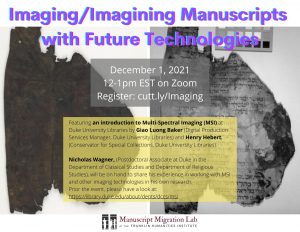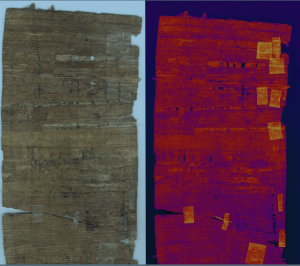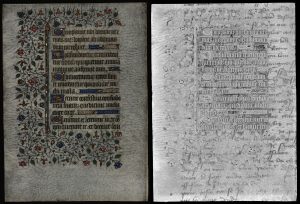 This past Wednesday, December 1st, the Lab hosted its final Fall Digital Humanities Workshop for the season: “Imag(in)ing Manuscripts with Future Technologies”. One of the technologies covered was Multi-Spectral Imaging, thanks to presentations by Giao Luong Baker, Digital Production Services Manager at Duke University Libraries (DUL), and Henry Hebert, DUL Conservator for Special Collections. The event’s slides–among other links–have been added to the MML Sakai under “Resources: Digital Humanities Workshops: Imag(in)ing Manuscripts…”, and are linked below.
This past Wednesday, December 1st, the Lab hosted its final Fall Digital Humanities Workshop for the season: “Imag(in)ing Manuscripts with Future Technologies”. One of the technologies covered was Multi-Spectral Imaging, thanks to presentations by Giao Luong Baker, Digital Production Services Manager at Duke University Libraries (DUL), and Henry Hebert, DUL Conservator for Special Collections. The event’s slides–among other links–have been added to the MML Sakai under “Resources: Digital Humanities Workshops: Imag(in)ing Manuscripts…”, and are linked below.
Multi-Spectral Imaging is a process by which a series cameras take photographs of a document using different wavelengths.  These images are processed through softwares, which compile the data and create a single image.
These images are processed through softwares, which compile the data and create a single image.
In order to submit an MSI request, a researcher has to fill out a Workflow Service Request Form. Requests can take two to four weeks to process. No more than three pages or items can be imaged in one request. The researcher has to have already seen the document physically at Duke University Libraries, and must detail in their request form the research question an MSI scan would help answer.
Manuscript pictured: 3rd century, B.C.E Greek literary papyri subject to MSI, revealing tape ‘repairs’.
 While MSI images are especially helpful for provenance research, text clarification, and repair history investigation, other methods may be more better suited to everyday use. The Lab’s own Dr. Nick Wagner shared information on these helpful, practical imaging technologies. A PDF of his slides is available below.
While MSI images are especially helpful for provenance research, text clarification, and repair history investigation, other methods may be more better suited to everyday use. The Lab’s own Dr. Nick Wagner shared information on these helpful, practical imaging technologies. A PDF of his slides is available below.
Manuscript pictured: Latin MS 221 Palimpsest, Rubenstein Library, subject to MSI.
PDF, Slides, Multi-Spectral Imaging at DUL: MSI_Dec2021_Slides.
Link, MSI Request form, DUL: https://tinyurl.com/msirequest.
Link, MSI technologies overview, DUL: https://library.duke.edu/about/depts/dccs/msi.
PDF, Slides, Nick Wagner, alternate imaging technologies: Researcher-based opportunities for image-based investigation.
